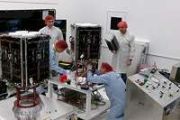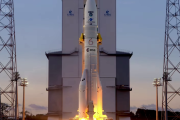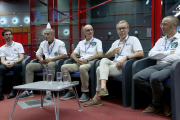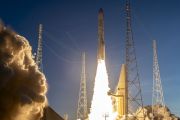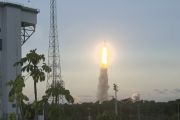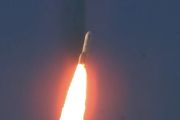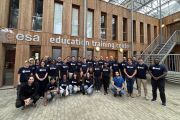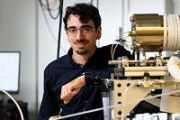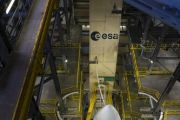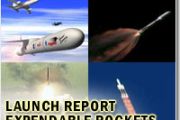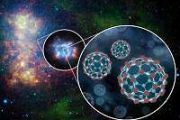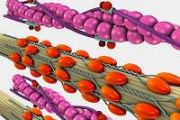
Copernical Team
China publishes technical requirements for key civilian BDS products
 China has published six documents detailing technical requirements and test methods for key civilian products using the BeiDou Navigation Satellite System (BDS).
The documents have been issued to facilitate the construction of a certification system for key BDS-3 products, according to the China Satellite Navigation Office.
Technical requirements and test methods were drafted for c
China has published six documents detailing technical requirements and test methods for key civilian products using the BeiDou Navigation Satellite System (BDS).
The documents have been issued to facilitate the construction of a certification system for key BDS-3 products, according to the China Satellite Navigation Office.
Technical requirements and test methods were drafted for c Airbus space technology reaches Mars
 When NASA's Perseverance rover lands on the surface of the Red Planet next Thursday, key Airbus technology will be on board: the MEDA meteorological station will provide scientists with valuable Mars weather data and the High Gain Antenna System will ensure a high-speed comms link with Earth for the duration of the MARS2020 mission.
Perseverance will use seven scientific instruments to stu
When NASA's Perseverance rover lands on the surface of the Red Planet next Thursday, key Airbus technology will be on board: the MEDA meteorological station will provide scientists with valuable Mars weather data and the High Gain Antenna System will ensure a high-speed comms link with Earth for the duration of the MARS2020 mission.
Perseverance will use seven scientific instruments to stu HKU planetary scientists discover evidence for a reduced atmosphere on ancient Mars
 Both Earth and Mars currently have oxidising atmospheres, which is why iron-rich materials in daily life develop rust (a common name for iron oxide) during the oxidation reaction of iron and oxygen. The Earth has had an oxidising atmosphere for approximately two and a half billion years, but before that, the atmosphere of this planet was reducing - there was no rust.
The transition from a
Both Earth and Mars currently have oxidising atmospheres, which is why iron-rich materials in daily life develop rust (a common name for iron oxide) during the oxidation reaction of iron and oxygen. The Earth has had an oxidising atmosphere for approximately two and a half billion years, but before that, the atmosphere of this planet was reducing - there was no rust.
The transition from a Biotech fit for the Red Planet
 NASA, in collaboration with other leading space agencies, aims to send its first human missions to Mars in the early 2030s, while companies like SpaceX may do so even earlier. Astronauts on Mars will need oxygen, water, food, and other consumables. These will need to be sourced from Mars, because importing them from Earth would be impractical in the long term. In Frontiers in Microbiology, scien
NASA, in collaboration with other leading space agencies, aims to send its first human missions to Mars in the early 2030s, while companies like SpaceX may do so even earlier. Astronauts on Mars will need oxygen, water, food, and other consumables. These will need to be sourced from Mars, because importing them from Earth would be impractical in the long term. In Frontiers in Microbiology, scien The geological context of the Mars 2020 landing site through the eyes of DLR
 On Thursday, 18 February 2021, at approximately 21:55 CET, NASA's control centre in Pasadena should receive the radio signal indicating that the Perseverance rover has been gently lowered onto the surface of Mars by a 'sky crane' as part of NASA's Mars 2020 mission. Perseverance's new home will be the floor of a former lake in the Jezero impact crater. There, the mobile laboratory, which is the
On Thursday, 18 February 2021, at approximately 21:55 CET, NASA's control centre in Pasadena should receive the radio signal indicating that the Perseverance rover has been gently lowered onto the surface of Mars by a 'sky crane' as part of NASA's Mars 2020 mission. Perseverance's new home will be the floor of a former lake in the Jezero impact crater. There, the mobile laboratory, which is the The Mars Relay Network Connects Us to NASA's Martian Explorers
 A tightly choreographed dance between NASA's Deep Space Network and Mars orbiters will keep the agency's Perseverance in touch with Earth during landing and beyond. When NASA's Mars 2020 Perseverance rover touches down with the Ingenuity Mars Helicopter on the Red Planet on Feb. 18, they won't be alone. From orbit, two robotic buddies will be playing a special role in the event by checking in on
A tightly choreographed dance between NASA's Deep Space Network and Mars orbiters will keep the agency's Perseverance in touch with Earth during landing and beyond. When NASA's Mars 2020 Perseverance rover touches down with the Ingenuity Mars Helicopter on the Red Planet on Feb. 18, they won't be alone. From orbit, two robotic buddies will be playing a special role in the event by checking in on Staying long-term on Mars
 The "red planet" in the evening sky seems more and more within reach, as leading space agencies aspire astronaut missions to Mars in the future. Unlike the 1969 moon landing, these missions are designed for a long-term stay, which poses new challenges for science: In addition to a habitat, for example, the few materials brought from Earth must be used efficiently and sustainably to equip and fee
The "red planet" in the evening sky seems more and more within reach, as leading space agencies aspire astronaut missions to Mars in the future. Unlike the 1969 moon landing, these missions are designed for a long-term stay, which poses new challenges for science: In addition to a habitat, for example, the few materials brought from Earth must be used efficiently and sustainably to equip and fee NASA ready to land another rover on Mars
 With about 2.4 million miles (3.9 million kilometers) left to travel in space, NASA's Mars 2020 Perseverance mission is days away from attempting to land the agency's fifth rover on the Red Planet. Engineers at NASA's Jet Propulsion Laboratory in Southern California, where the mission is managed, have confirmed that the spacecraft is healthy and on target to touch down in Jezero Crater at around
With about 2.4 million miles (3.9 million kilometers) left to travel in space, NASA's Mars 2020 Perseverance mission is days away from attempting to land the agency's fifth rover on the Red Planet. Engineers at NASA's Jet Propulsion Laboratory in Southern California, where the mission is managed, have confirmed that the spacecraft is healthy and on target to touch down in Jezero Crater at around NASA fears gap in astronaut crew at multibillion-dollar space station
 Having spent well over $150 billion on the International Space Station, NASA fears a potential lack of launch vehicles could leave the orbiting platform without a U.S. astronaut and create a potential safety risk.
Such a gap would occur only if a crew had a problem that forced them to leave the space station early, but it would represent a costly "lost opportunity that cannot be regained"
Having spent well over $150 billion on the International Space Station, NASA fears a potential lack of launch vehicles could leave the orbiting platform without a U.S. astronaut and create a potential safety risk.
Such a gap would occur only if a crew had a problem that forced them to leave the space station early, but it would represent a costly "lost opportunity that cannot be regained" Media event: ESA seeks new astronauts
 Video:
01:00:00
Video:
01:00:00
For the first time in 11 years, ESA is looking for new astronauts to work alongside ESA’s existing astronauts as Europe enters a new era of space exploration.
Speakers include Jan Wörner, ESA Director General; Samantha Cristoforetti, ESA astronaut; Tim Peake, ESA astronaut; David Parker, ESA Director of Human and Robotic Exploration; Frank De Winne, ESA Low Earth Orbit Exploration Group Leader, Head of the European Astronaut Centre; Jennifer Ngo-Anh, ESA Research and Payloads Programme Coordinator, Human and Robotic Exploration; Lucy van der Tas, ESA Head of Talent Acquisition.
Press briefings in French, German, Italian, Spanish and Dutch, are






